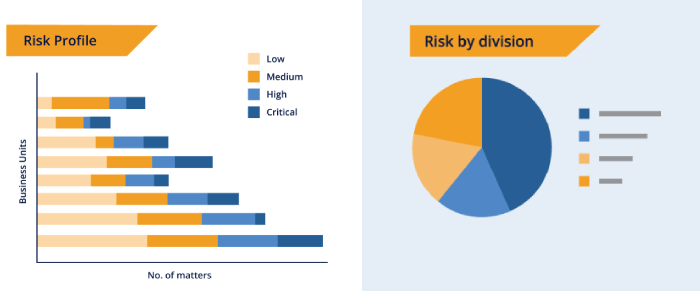Legal Department reporting should be more than a necessary evil: it’s an opportunity to connect with your Legal Department’s stakeholders and share critical information. This blog series addresses the art and science of legal reporting by audience. In short, who needs to know what?
Legal reporting for your CEO and Board
In "Great Expectations: What CEOs Want in a GC", Morrison Foerster put it exactly right: “Here’s the good news: Your CEO needs your business acumen, judgment and analytical skills more than ever. The bad news: Your CEO’s expectations of you have likely never been higher.”
Indeed, today’s CEO needs more than a lawyer. This was evident in a 2016 survey by the New York Stock Exchange which still rings true nearly a decade later: corporate directors and executive officers were asked how general counsel could add the most value to their organizations. Among their responses:
- Act as a proactive adviser to the board – 79%
- Act as a proactive adviser to the CEO – 73%
- Offer risk analysis expertise – 37%
- Contribute to business strategy discussion – 24%
- Support the execution of the business plan – 17%
Notably missing from this list: The simple execution of legal work.

A well-constructed legal report can boost your relationships with your highest-ranking stakeholders by putting the in-house Legal Department in the context of the business. If you’ve been relying on a quarterly text-heavy memo or email, it may be time for a pivot: legal reports that include visual charts and graphs will make your case far more effectively than a text-heavy document when reporting to the CEO and Board.
As one general counsel at BlueScope (and Xakia user) put it, lawyers think in blocks of text; business people think in charts and graphs.
Your executives and directors may be your most time-crunched demographic. Make it easy for them with simple and clear legal reports. What are the most critical pieces of information for the individuals responsible for the success of the organization as a whole?
Your top-level legal reports should focus on three key themes, reflective of the survey responses shown above. Below is a sample legal report for the CEO and Board and what it should include.

1. Risk
Provide a look at the organization’s most high-risk legal matters, then drill down into the individual business units. This will help your CEO and Board leaders spot trends in the business more broadly. And if you can show them how risk varies across geographies, product lines or business units, or how risk intensifies in one particular segment, you are well-positioned to start proactive discussions about diagnosing or mitigating the risk.
A simple pie chart will help your CEO and Directors to understand the spread of risk - from low through to critical - for both the organization as a whole, or for specific business units. This one visual is easily digested and understood, and demonstrates you can also identify and will prioritize the critical risk matters.

2. Strategy
How is your in-house Legal Department advancing the priorities set forth by the CEO and the Board?
Recall that 24% of corporate directors and executive officers believe their General Counsel will add the most value when they contribute to the business strategy discussion, and a further 17% believe that execution of the business plan is the priority. Demonstrating that you are doing this through your reporting is critical to your reputation and your relationship with your most senior stakeholders.
Demonstrating your strategic input can be tricky, but our legal reporting white paper guide to the mechanics of legal department reporting will show you how to illustrate your work’s strategic value with data. Check out our blog to learn how you can use data to align your legal department with business goals.
3. Budget
This may be optional for your Board, depending on its level of interest, but it’s a must for your CEO. Neither audience needs the accounting detail in the legal reports. Instead, think about graphics that can quickly show the top brass how legal resources are being used - and optimized.
For truly impactful legal reporting, combine the elements of risk, strategy and budget together. How much of your budget is going to high-risk and critical matters versus low-stakes queries? What percentage of your legal budget is going to high-strategic-value work versus matters that simply keep the lights on?
It’s metrics like these that will take your Legal Department from being perceived as a cost center to getting a seat at the table as a proactive adviser. Watch our webinar on demand and learn more about creating best-in-class in house legal department reports here.
How often should your CEO receive these legal reports?
Don’t drown your CEO in data – we recommend making these legal reports monthly. This will effectively complement reporting they make to their stakeholders. Chief Executive recommends a ‘monthly operations report’ as a best practice for highly-effective CEOs.
If creating a legal report for the Board, match it your board’s schedule – provide updates for each meeting and supplement as needed. This is likely to mean more often than quarterly, but less often than monthly.
We recommend:
Avoid over-communication
If you are attaching your report as a PDF, provide some direction in your email with the two to three key points. Keep it short.
Establish a rhythm
Deliver the legal report consistently each month – whether the 1st, the 15th, or at month’s end, make it reliable.
Be aware of legalese
Take care not to use legalese in your reports – write in direct business prose. Writing for the World Economic Forum, Lucy Marcus, the Founder and CEO of BBC News, warned those presenting to corporate boards to avoid jargon: “We are not necessarily experts in your field. Use clear language that everyone around the table will understand.”
Legal Department reporting - over time
Once your CEO and executive stakeholders have digested "point in time" data such as "our manufacturing division presents a constant and high risk to our business" it will be important for you to show how this changes over time. This demonstrates that the Legal Department is aware of risk and implementing change to mitigate it where possible.
A simple chart showing a timeline is all that is required to show legal risk changes over time, though you may like to consider its content within the context of other data that you have provided e.g. to focus on the high risk division or category identified in your other reporting. This data should be easily available from your legal matter management system, or automatically generated in out-of-the-box in-house legal reports.

Download our legal department reporting white paper to get started
We recognize that creating different reporting formats can sound formidable. We’re here to help: Download our guide, Best-in-Class Legal Reporting, and see clear instructions for content, cadence and delivery, including sample CEO and Board reports. Our legal reporting white paper also includes advice for other audiences in your organization including business unit heads, the Legal Department, and the General Counsel.
Moreover, with Xakia's legal analytics software, these legal department reports can be automated, so you can get attractive, actionable reports – without adding to your to-do list. To learn more about Xakia's legal matter management software and how we can help show the value of your Legal Department, get in touch with the team to book a demo today.
